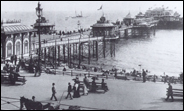There's Life Yet in the
Seaside's Tottering Old Lady
By WARREN HOGE
BRIGHTON, England, Jan. 5 - Brighton's West Pier was the "pier of the realm," the most exuberant piece of Victorian marine architecture in England. Today, it is crumbling into the waves long ruled by Britannia and struggling to keep the last of its faded dignity from being washed away.Whether to stop its slide into the sea or let it continue its graceful decay has been a subject of dispute in this English Channel city for some time, but the argument took on new urgency just before New Year when the brine-lashed pilings beneath the concert hall with its fanciful pagodas and balconies gave way, and a sizable chunk of the ornate structure collapsed.
Built in 1866 and closed for safety reasons in 1975, the pier was to have been well on its way to restoration to its 1920's heyday splendor by now under a $23 million grant from government millennium project funds. But action was held up by a dispute with the competing Palace Pier at the other end of the seafront and objections from some townspeople to a proposed adjoining commercial complex mandated by the terms of the financing.
Boosters of the restoration have faced what could be the downfall of their dreams with stiff upper lip determination.
"You might say it has awakened everyone to the possibility that when we were saying that the pier could collapse at any moment, we were rather more accurate than people gave us credit for," said Rachel Clark, general manager of the West Pier Trust, the current owner.
A spokesman for the Brighton and Hove City Council said: "This is not the end of the pier. The plans will now move more swiftly than ever."
Heritage is a big and contentious business in Britain, and many people questioned whether reconstructing a ruin was the best way to preserve the past.
"I am very, very fond of the pier - I remember going there with my grandfather in the 50's - but there comes a time in the life of a structure when it's probably done its job," said George Furguson, 55, president-elect of the Royal Institute of British Architects. "One needs to look at the right balance. When you come to virtually rebuild something, it is not the same as it was; it becomes a pastiche. The West Pier had already gotten past the point of no return, and now that it has collapsed, it is certainly past it."
Besides, he suggested, the very purpose of piers is now passé.
"Piers were built for promenading, and we don't promenade in bustles and toppers anymore. The piers that are left have become very tacky experiences, so we should be thinking what we want piers for."
Where the West Pier once rang with the laughter of animated crowds strolling the hardwood decking, it echoes now only to the cawing and mewling of gulls and the clatter of waves washing back and forth over the rocks and pebbles that locals wistfully call a beach.
Built initially as walkways to paddle steamers, piers became fashionable places for "promenading" and then introduced shops, variety halls and amusement arcades to attract the public.
As such, they became the very symbol of beach resort life in Britain. At the turn of the last century, 80 piers existed around the coast, but only half of them have survived the ravages of age, shipping accidents, fires and the uncaring weather of the British coastline.
In recent decades, people who once flocked to "end of the pier" shows to attend pop concerts, variety acts and comedy turns were wooed away to Continental shores where the sun shines, the beaches have sand, and you don't have to wear a windbreaker to take the sea breezes.
Millions still go to the British seaside, but they are often day-trippers who do not stick around for the evening entertainment that used to bring visitors crowding into pier theaters.
The West Pier occupies a special spot in British affections. It is the only pier that enjoys the top heritage grade 1 designation and was famed as the favored place for Edwardians to pursue the fastidious pleasure of venturing into the water without getting wet. It also charged admission fees to keep the riffraff below, making it the marine embodiment of the upstairs-downstairs class structure of the society of its time.
Ms. Clark does not plan to put back the old exclusionary tolls, but she does mean to devote her reconstructed pier to activities that she said would set it off from the Palace Pier and its pinball games, slot machines, Karaoke bar, fast food counters and cotton candy stands.
She is promising a performance space, a heritage museum and an upscale restaurant with a signature chef.
Tim Mikleburgh, chairman of the National Piers Society, said he thought the contesting piers could coexist. "There is no reason for selfishness, " he said. "Brighton used to support two successful piers and can do so once again."
Karin Janzon, 54, a local health care consultant and fan of the West Pier, agreed and said she believed the two piers captured the disparate sides of Brighton. It is a place of regal origins - with stately Regency architecture and a Royal Pavilion built in the 1820's for George IV - that has now become a raffish city of 225,000 people.
"Every time I walk along the seafront and see the grand majestic West Pier and the cheeky Palace Pier twinkling behind, I smile," she said. "What a couple - perfectly matched in their contrast, and perfectly encapsulating the beauty and vitality of Brighton's mix of high and low life, clinking money machines and dreams beyond reason."
HOME
Pier to Pier

